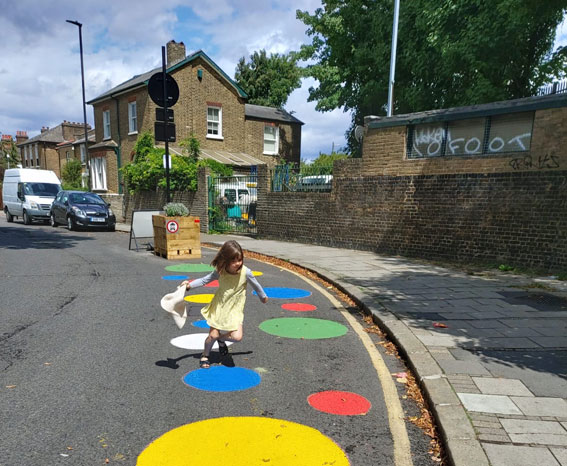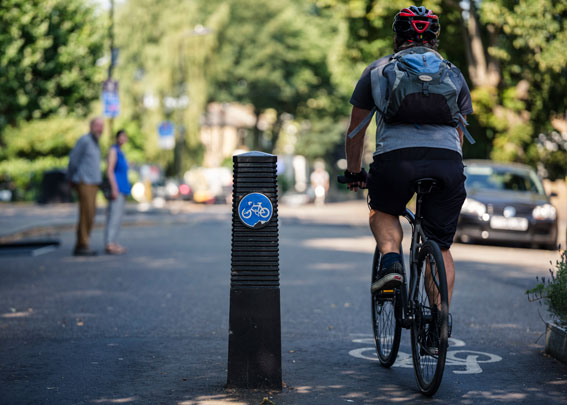LOW TRAFFIC NEIGHBOURHOODS AND SOCIAL HOUSING
Low Traffic Neighbourhoods (LTNs) help make streets easier to walk, wheel or cycle on, by stopping motor vehicles from using quiet roads as shortcuts.
Also known as 'mini-Hollands', they've been in London since the 1970s, and more of them were introduced in the city in Spring 2020.
In this blog post, Jeremy Leach from Southwark Living Streets Group explains how LTNs have brought benefits to his neighbourhood of Walworth, an area of London with a large amount of social housing.

A little girl plays in a Low Traffic Neighbourhood
HOW THE WALWORTH SCHEME BEGAN
Like many other places, Walworth has seen the impact of the 'sat-nav revolution'. For the past decade or so, more traffic has been funnelled down our side streets, and some of them had become almost out of bounds to pedestrians and cyclists.
When the first Covid lockdown began in March 2020, we were struck by the huge difference it made. The previously busy streets became far safer. They became more pleasant routes for people to exercise, and to make their essential journeys to our high street, the Walworth Road.
Before the pandemic struck, there had been a lot of work by Southwark Council and Impact on Urban Health to tackle health inequalities and disadvantage in the area.
The Walworth Low Emission Neighbourhood project, funded by the Mayor of London, had helped identify many issues preventing more people from walking, wheeling and cycling. They found car ownership was low in the area and people relied on public transport and accessible walking routes to get around.
Building on this work to understand the issues locally, Southwark Council created three large Low Traffic Neighbourhoods between July and December 2020.
Link to map (select housing estates)
Contains public sector information licensed under the Open Government Licence v3.0.
A BOOST TO WALKING AND CYCLING
The initial findings on the impact of the schemes have been extremely positive, with overall traffic levels down and cycling up.
There has been a collapse in the number of cars being driven within the LTNs. It seems clear that people are walking more and feel more confident doing so. It's now common to see people feeling safe enough to walk in the middle of the road, a common sight on minor roads with little or no through traffic. This means that families with small children or young people can reclaim spaces to play outdoors and explore their residential streets uninhibited by constant traffic and increased pollution from it.
Of course, there is more to do to improve our high street. The Walworth Road still has large amounts of traffic that is moving too fast. But a big change has happened.
"What's really exciting is just how good Low Traffic Neighbourhoods are at delivering big change for a relatively low cost."

A cyclist and pedestrians at a junction
LISTENING TO COMMUNITIES
What's really exciting is just how good Low Traffic Neighbourhoods are at delivering big change for a relatively low cost. When the right locations are chosen, they can be a tool in improving the lives of all of us, whatever streets and homes we live in.
But to bring the benefits of LTNs to more places, we need to recognise the differences between areas, and involve local people in the process.
We need to take the time to engage properly with residents, listen to people and collaborate with communities. In doing so, people are more likely to understand and support the process, and trust the data we gather.
Not everywhere is like Walworth - there is no 'one size fits all'. LTNs sometimes face criticism, and there needs to be meaningful consultation, where residents' concerns are listened to.
Furthermore, LTNs need to be part of a range of solutions, such as improving public transport, lowering speed limits, and not building in car dependency through planning.
Done well, they can help more people feel the benefits of safer, healthier and more pleasant streets. There might even be a local group near you that is part of this process of community dialogue that you can add your voice to.
"Families with small children or young people can reclaim spaces to play outdoors and explore their residential streets."

INFORMATION AND RESOURCES
While introducing low traffic neighbourhoods is not without its challenges, examples from across London have shown they do work and once in, are incredibly popular.
Read more about our work on walkable neighbourhoods and LTNs, or download the guide from London Cycling Campaign and Living Streets.

About the author
Jeremy Leach
Living Streets